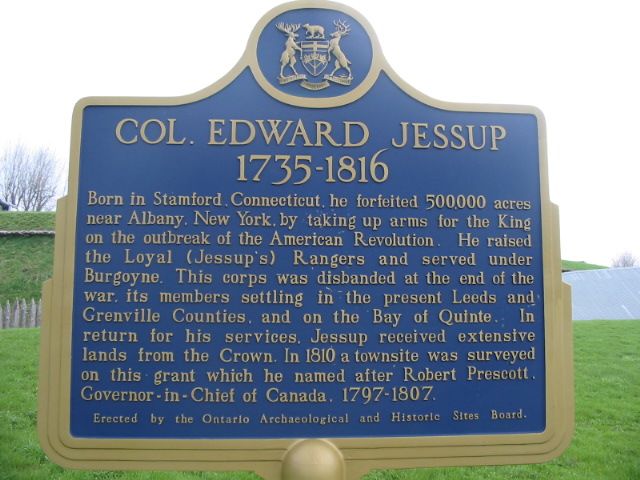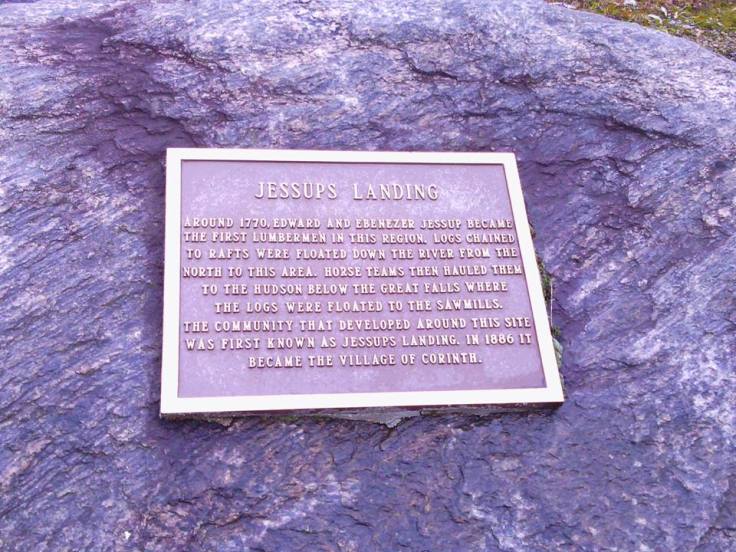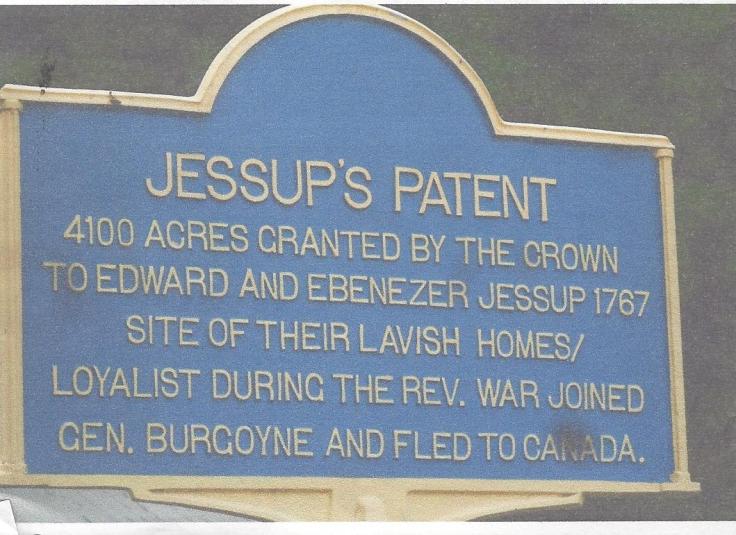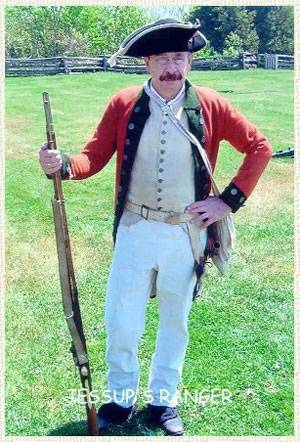There are at least 5 heritage markers in Prescott that commemorate the Jessup family and the Town’s founder, Col. Edward Jessup.

One of the earliest plaques, located in front of Fort Wellington, reminds us that Edward Jessup forfeited nearly 500,000 acres north of Albany, New York, by taking up arms for King George III at the outbreak of the American Revolution.
My great-great-great grandfather, John Bateast Belrose, married Nancy Ann Bonisteel, whose father, Jacob, and uncle, Philip, served with Jessup’s Rangers for 7 years. Jacob and Philip were 18 and 19 when they enlisted in 1777.
Edward Jessup was the eldest son of Joseph and Abigail James Jessup and the older brother and associate of Ebenezer Jessup, a trained surveyor. Although the Jessups had lived in Connecticut for several generations, Joseph moved the family to the Upper Nine Partners Patent in Dutchess County, in 1744, shortly after his wife’s death. This is likely where the Jessups and Bonisteels met – the Bonisteels lived in Pine Plains and Rhinebeck, and operated businesses in Red Hook.
Edward raised a company and served as a Captain, during the Seven Years’ War. He participated in Jeffery Amherst’s campaign of 1759 in the Lake Champlain region, and immediately recognized the value of the area. Near the close of the War, the region around Lake George and the Upper Hudson was considered safe again for settlers. A royal proclamation was issued, and Edward and Ebenezer began operations from Albany, acquiring extensive holdings in New York State, in what is now Hamilton, Essex and Warren counties. Some of this land – such as the Totten and Crossfield Purchase of more than 800,000 acres – involved petitioning the Governor of the Province of New York for the right to purchase “wild lands” ceded by the Mohawks and Caughnawagas.

Edward and Ebenezer Jessup were among the first great lumber barons of the Adirondacks, building sawmills on the Hudson River and rafting logs downstream to their mills. They started a community on the river named Jessups Landing (Village of Corinth, today). They maintained a ferry and a road that followed the river upstream to Jessups Falls, now known as Rockwell Falls, near the junction of the Hudson and Sacandaga rivers.
In 1760, Edward married Abigail Dibble and by 1761, Ebenezer was married to Elizabeth Dibble. His wife was the sister of Edward’s wife, brothers marrying sisters.

By 1770, the Jessups had settled on one of their grants on the Hudson River, about ten miles northeast of Glens Falls. They built spacious log homes, and were noted for their ability to entertain lavishly in “the wilderness”. At the same time, they were aware of the increasing unrest among colonists in the area and, along with other Loyalists, began formulating plans as they quickly lost favor among the American rebels.
During the winter of 1775, although the War of Independence had not been declared, the colonists began to burn the mills at Jessups Landing and to destroy the ferry. The mills were closed down and workers laid off. At the threat of death, at the hands of the Americans, the Jessups fled up the Sacandaga River on snowshoes where they joined other Loyalists at Fish House, an early settlement and fishing camp. From there, the party continued to Canada.

When Sir Guy Carleton succeeded in driving the American forces out of the province of Québec in the summer of 1776, the Jessups led a party of some 80 Loyalists to join him at Crown Point, New York. Edward Jessup’s previous experience during the Seven Years’ War would prove useful. The campaign began with success at Ticonderoga, but collapsed with the surrender of General John Burgoyne and his army at Saratoga in October 1777.
In May 1777, 31 Loyalists were pursued and captured on or near Jessup’s Patent. All admitted they were on their way to join General Burgoyne. Local tradition has it that Edward Jessup escaped by leaping 12 feet across the Hudson River. The Militia subsequently destroyed homes and burned grain fields.
Both Edward and Ebenezer were named in a 1779 bill in the New York Legislature, in which
“…each of them are hereby severely declared to be Ipso Facto, convicted and attainted of the offence aforesaid (adhering to the enemies of the State) and that all and singular the estate both real and personal held or claimed by them the said persons severally and respectively whether in possession, reversion or remainder, within this State on the day of the passing of this Act shall be and hereby is declared to be forfeited and invested in the people of the State.
Sec. II And be it further enacted by the authority aforesaid, – That the said several persons herein before particularly named shall be and hereby are declared to be forever banished from this State; and each and every of them who shall at any time hereafter be found in any part of this State shall be and are hereby adjudged and declared guilty of felony and shall suffer death, as in cases of felony, without benefit of clergy.”
Exiled, Edward Jessup sent his family to safety in Canada while he led Loyalist Rangers in two incarnations until they were disbanded in December 1783. He and many of his surviving soldiers settled in Canada along the St. Lawrence River. They were allotted townships No. 6 (Edwardsburgh), No. 7 (Augusta), part of No. 8 (Elizabethtown), as well as No. 2 (Ernestown) west of Kingston. Jessup spent the spring of 1784 supervising the settlement of his men and their families, and in the fall of that year travelled to England to submit a claim for his losses during the Revolution. He returned empty-handed, and with his son, Lieut. Edward Jessup, founded the town of Prescott. From about 1810 onward, Col. Edward Jessup was ill and bedridden. He was eighty when he died in Prescott, in February 1816.
My great-great-great-great grandfather, Jacob Bonisteel received land in Edwardsburgh Township, and settled with his wife, Christian Welch. They had a large family. Nancy, the youngest, was born in about 1805, and married John Bateast Belrose in 1830. Their eldest sons – Jacob and Michael Belrose – moved to the Bruce Peninsula in 1875, and helped found the Town of Tobermory. Jacob is my great-great grandfather, and the log cabin he built is now part of the St. Edmunds Township Museum.
Sources: http://www.warrencountyhistoricalsociety.org/rewind-back-issues-2012/rewind-back-issuew-2015/rewind-february-1-2015-the-jessups-adirondack-land-barons/ & https://archive.org/details/edwardjessupofwe00jesu
Jessup’s Ranger Photo: http://fencibles.ca/news.php

Leave a comment